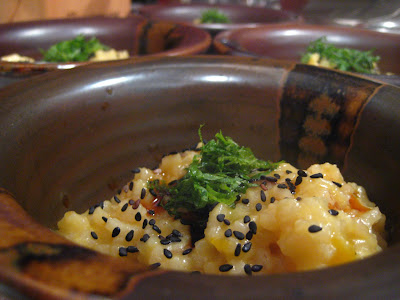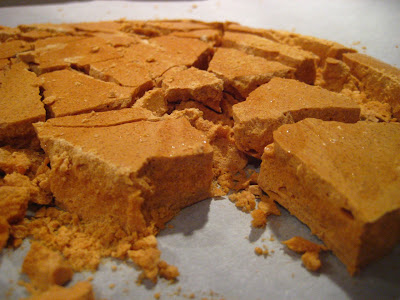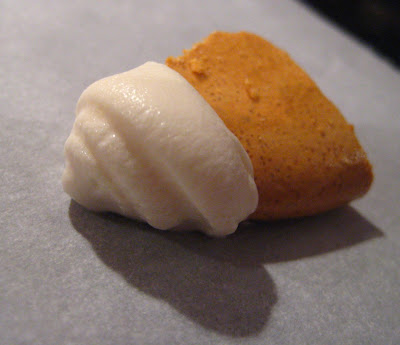I started with a risotto - but one based entirely on basic Japanese ingredients. Instead of using olive oil to saute and brown the rice, I used sesame oil. Instead of vegetable or meat stock I used a broth from smoked bonito, sardine, and kelp with some white miso paste for texture and flavour depth and a little bit of ginger. Instead of wine I used mirin. The vegetables were kabocha squash and shiitake mushrooms. And to garnish, black sesame seeds, super-finely sliced shiso, and soy sauce. I still used arborio rice for texture, and I also used a very little cheese to hold it together - a very light-flavoured hard Mahon.
 The entire recipe was my attempt at a sort of macro-scale fusion recipe. I wanted to see if the texture of risotto could be successfully combined with entirely Japanese flavour. I'm excited that the result is a resounding "yes!" The mouth-feel of this experiment was exactly the same as my more traditional risotto recipes, but the taste was of a sweet miso-mushroom soup with the umami of soy, toasty overtones of sesame, and sweet earthy bites of squash. The greatest, yet most subtle, change was definitely the liquids. It was hard to really identify how the fish stock and miso differed from chicken or vegetable stock, but the effect on the final dish is great. I think the european-style stocks have much more onion, carrot, garlic, and savory herbs than their Japanese counterparts. Mirin is also worlds apart from white wine - much sweeter and with slightly beery flavour. I think that's why the dish came out sweet - next time I'll use less.
The entire recipe was my attempt at a sort of macro-scale fusion recipe. I wanted to see if the texture of risotto could be successfully combined with entirely Japanese flavour. I'm excited that the result is a resounding "yes!" The mouth-feel of this experiment was exactly the same as my more traditional risotto recipes, but the taste was of a sweet miso-mushroom soup with the umami of soy, toasty overtones of sesame, and sweet earthy bites of squash. The greatest, yet most subtle, change was definitely the liquids. It was hard to really identify how the fish stock and miso differed from chicken or vegetable stock, but the effect on the final dish is great. I think the european-style stocks have much more onion, carrot, garlic, and savory herbs than their Japanese counterparts. Mirin is also worlds apart from white wine - much sweeter and with slightly beery flavour. I think that's why the dish came out sweet - next time I'll use less.Making this dish gave me a great excuse to go to Uwajimaya, the glorious Japanese supermarket. Since I don't read Japanese, figuring out which is the right dried soup base to use and how to use it, or which miso paste is which, is always fun - involving deciphering packaging diagrams and finding numbers in the directions from which to interpret measurements, timing, and whether something might kill you if eaten wrong.
The second course was a pork tenderloin, rubbed with a paste made from cocoa nibs from Theo Chocolate, wild peppercorns, sugar, olive oil, sage, paprika, and cumin. I ground the spices and chocolate with a mortar and pestle, adding a little olive oil at a time until the paste became the consistency of a dense chocolate mousse. Plain, the mixture tasted tart and nutty, with a little heat from the paprika and pepper and some dusty warmth from the sage. Rubbing it on the pork smelled like paprika and chocolate. Baking it smelled like cumin plus some sweet smoke. And eating it was a very mild nutty aftertaste to the pork, which I slightly overcooked. It looked really good, but wasn't as richly flavoured as I'd hoped. Perhaps marinating in the rub overnight would have allowed the flavours to penetrate and develop. So the verdict: tasty, but a little mundane.
 The accompaniment to the pork was shaved par-boiled golden beets with sea salt, pepper, and truffle oil. Boiling the beets made them not quite so crunchy, but I kept some firmness by not boiling too long and then immediately chilling the beets in cold water. Shaved vegetables are fun to arrange because they are so malleable and delicate. These came out looking like fluffy yellow roses on the plate. And they tasted sweet and grassy at the same time - the salt magnifying the sweetness, the pepper adding a little tart twinge, and the truffle oil smoothing out the texture and rounding out the taste. I also used some leftover shiso to garnish this plate, and the shiso went surprisingly well with the beets - a cool and herbal complement to the sweetness of the beet.
The accompaniment to the pork was shaved par-boiled golden beets with sea salt, pepper, and truffle oil. Boiling the beets made them not quite so crunchy, but I kept some firmness by not boiling too long and then immediately chilling the beets in cold water. Shaved vegetables are fun to arrange because they are so malleable and delicate. These came out looking like fluffy yellow roses on the plate. And they tasted sweet and grassy at the same time - the salt magnifying the sweetness, the pepper adding a little tart twinge, and the truffle oil smoothing out the texture and rounding out the taste. I also used some leftover shiso to garnish this plate, and the shiso went surprisingly well with the beets - a cool and herbal complement to the sweetness of the beet.The next course was dumplings (ravioli, really) of goat cheese, carrot, and onion. I grated the carrot and onion with the brilliant multi-purpose "Kitchen Mama" tool I got at Daiso. This grater produces basically a rough paste of anything put to it (including knuckles, I'm sorry to say.) When you pulverize vegetables to such an extent, lots of the liquid comes out. As I didn't want the filling to be watery anyway, I used a looseleaf tea bag to squeze off all excess moisture. Cheesecloth would work, too, but more stuff sticks to it and the tea bag was already a convenient pouch-shape. Note, as well, that when you grate onion it's that much more potent - whew! I mixed the drained carrot and onion with plain fresh goat cheese and a little salt and pepper.
 As wonderful as it is to hand-make dumpling skins, this is where I decided to cut a corner. I found, after much searching, locally-made, freshly-packed shu-mei skins that did not contain all of the preservatives and stabilizers common to nationally-distributed ones. They're basically just a delicate circular noodle. You put a bit of filling in the middle, run a wet finger around the edge, fold in half, and press opposite edges together to make a little fat half-moon. Honestly, you could put anything in them (and I intend to try!) I fried the finished dumplings in canola oil though you can steam them, too. Shu-mei skins are very delicate so these were finished quickly - puffy, crisp and golden once I finally got the oil temperature right. Next time I'll use a thermometer so I can tell you what "right" really was, though I'm sure you can find lots of frying info online. There wasn't actually much taste of carrot, despite the amount I used. The cheese was dominant, with a little onion and a little sweetness reminiscent of fresh carrot juice.
As wonderful as it is to hand-make dumpling skins, this is where I decided to cut a corner. I found, after much searching, locally-made, freshly-packed shu-mei skins that did not contain all of the preservatives and stabilizers common to nationally-distributed ones. They're basically just a delicate circular noodle. You put a bit of filling in the middle, run a wet finger around the edge, fold in half, and press opposite edges together to make a little fat half-moon. Honestly, you could put anything in them (and I intend to try!) I fried the finished dumplings in canola oil though you can steam them, too. Shu-mei skins are very delicate so these were finished quickly - puffy, crisp and golden once I finally got the oil temperature right. Next time I'll use a thermometer so I can tell you what "right" really was, though I'm sure you can find lots of frying info online. There wasn't actually much taste of carrot, despite the amount I used. The cheese was dominant, with a little onion and a little sweetness reminiscent of fresh carrot juice. Sponge candy was completely unknown to me until I started looking for a way to reproduce the core of the Whopper. No, not the hamburger - that I can do. I mean that mysteriously crisp and malty candy covered in chocolate. There are al sorts of approximations out there, but the one that seems to hold the most promise is sponge candy. As I mentioned, I'd never heard of it, but when I told my mother she exclaimed, "Oh yeah, like honeycomb. I love honeycomb! Oh, can we please make some when you come home for Thanksgiving?!" So it appears I missed something. That, or it was popular in the 1950s. Likely the latter, since candymaking is something of a vanishing art.
 It is very simple: sugar, vinegar, and baking soda. Remind anyone of science-project volcanoes? When you mix the baking soda into the vinegar-primed melted sugar, and stir like crazy, you get lots of little expanding bubbles trapped in the sugar. When you pour out the sugar into an oiled baking dish and let it cool, it hardens into a delicate, crunchy sugar matrix (that you break apart by hitting it with a hammer!) To get it malty, I added malt powder mixed with the baking soda. Malt powder is basically another type of dried, crystallized sugar (maltose, among a few others.) But it has that very distinctive flavour (of Whoppers!) Suffice to say, I, too, ow love sponge candy, especially malted. I'm going to try another batch with more malt and also using the recommended half-sugar-half-corn syrup mixture (which should enable me to get the molten sugar to hard-crack temperature with less browning and also enable a lighter, fluffier candy when hardened.) But still: yum!, especially when dipped in leftover cream cheese frosting from birthday-cake adventures.
It is very simple: sugar, vinegar, and baking soda. Remind anyone of science-project volcanoes? When you mix the baking soda into the vinegar-primed melted sugar, and stir like crazy, you get lots of little expanding bubbles trapped in the sugar. When you pour out the sugar into an oiled baking dish and let it cool, it hardens into a delicate, crunchy sugar matrix (that you break apart by hitting it with a hammer!) To get it malty, I added malt powder mixed with the baking soda. Malt powder is basically another type of dried, crystallized sugar (maltose, among a few others.) But it has that very distinctive flavour (of Whoppers!) Suffice to say, I, too, ow love sponge candy, especially malted. I'm going to try another batch with more malt and also using the recommended half-sugar-half-corn syrup mixture (which should enable me to get the molten sugar to hard-crack temperature with less browning and also enable a lighter, fluffier candy when hardened.) But still: yum!, especially when dipped in leftover cream cheese frosting from birthday-cake adventures. Last of the evening was a nightcap. A fabulous bar called Knee High Stocking Company makes a drink called the "St. James Cooler" that is a mixture of Jameson whiskey, St. Germain elderflower liqueur, lemonade, mint, and soda. I've had it. It is delicious and refreshing. And it inspired me to try a similar concoction, though a calmer version. I mixed 1 measure Powers' Whiskey, 1/2 measure Extra Dry White Vermouth, 2 Tablespoons elderflower concentrate ("Fladersaft" from Ikea, of all places), and a dash (1/8 tsp) lavender vodka that I made last year. More on the vodka some other time. Shake up that mixture with ice and serve neat. Refreshing and relaxing at the same time. I think it could be good both before and after dinner.
Last of the evening was a nightcap. A fabulous bar called Knee High Stocking Company makes a drink called the "St. James Cooler" that is a mixture of Jameson whiskey, St. Germain elderflower liqueur, lemonade, mint, and soda. I've had it. It is delicious and refreshing. And it inspired me to try a similar concoction, though a calmer version. I mixed 1 measure Powers' Whiskey, 1/2 measure Extra Dry White Vermouth, 2 Tablespoons elderflower concentrate ("Fladersaft" from Ikea, of all places), and a dash (1/8 tsp) lavender vodka that I made last year. More on the vodka some other time. Shake up that mixture with ice and serve neat. Refreshing and relaxing at the same time. I think it could be good both before and after dinner.So that was the feast. I loved making it and my friends loved eating it and ultimately that's what it's all about.
RECIPES:
JAPANESE RISOTTO
1 C Arborio rice
3 T Sesame oil
3 C Fish stock
1 C Mirin
Double-handful Shiitake mushrooms, sliced
Double-handful Kabocha squash, cubed
1/3 C White Miso
1/3 C Mahon cheese, grated
Garnish:
Shiso Leaf, finely sliced
Black Sesame Seeds
Soy Sauce
1. Over medium-high heat, toast rice in sesame oil until rice is slightly transparent and starting to brown.
2. Add 2 C fish stock and squash, reduce heat to low, and simmer, stirring frequently.
3. When most liquid gone, add remaining stock, mirin and mushrooms. Continue simmering and stirring.
4. When all liquid gone, add cheese and stir to melt.
Garnish servings with shiso, soy sauce and sesame seeds.
CHOCOLATED-PEPPERCORNED PORK TENDERLOIN
1 Pork Tenderloin (they're mostly about the same size).
2 T Cocoa Nibs
1 T Sugar
1 T Wild Peppercorns
2 T Olive Oil
1/4 t Cumin, ground
1/2 t Paprika, ground
1 t Sage, ground
1. Grind the cocoa nibs and sugar to a paste in a mortar and pestle.
2. Add peppercorns and some oil and grind to paste.
3. Add herbs and a little more oil. Grind into paste.
4. Add a little more oil and grind fast until the paste becomes aerated and almost a mousse.
5. Trim pork and rub with paste.
6. Bake at 350 until just center is still pink.
7. Remove from oven, cover with foil, and rest for 10 mins.
GOLDEN BEET FLOWERS
Golden Beets
Sel Gris
Truffle Oil
1. Bring a pot of water to a boil.
2. Peel the beets and boil them whole until a knife slides in easily, but not all the way through.
3. Pour water from pot and then set under cold running tap to cool beets.
4. Remove beets from cold water when cool, dry, and shave with mandoline.
Mound on plate and garnish with salt and oil.
CARROT-ONION DUMPLINGS
Shu-Mei Skins
2 Carrots
1 Onion, small
1/3 C Goat Cheese, fresh and plain
Salt and Pepper
1. Grate carrots and onion.
2. Mix with cheese and season to taste (not too much salt.)
3. Place a teaspoon of filling into the middle of a wrapper, moisten the edge of the wrapper with a finger dipped in water, fold over and press wrapper edges together. Try not to leave much empty space inside the dumpling - they can pop when cooked.
4. Fry in your oil of choice. Cook a few at a time to keep oil at the same temperature.
MALTED SPONGE CANDY
(This is the recipe as it should be, not exactly as I tried it the first time.)
1 C Sugar
1 C Corn Syrup
1 T White Vinegar
1 T Baking Soda
1/3 C or more Malt Powder (You can get different kinds from any homebrew supply store - I used amber.)
1. Grease a glass baking dish. (Some recipes say use metal and butter but I had good luck with Corningware greased with canola oil.)
2. Heat sugar, vinegar and corn syrup slowly, stirring constantly. Use a pot of at least 2 quarts to allow for expansion.
3. Pre-mix baking soda and malt powder (I've yet to try adding the malt powder earlier or changing the amount of baking soda or vinegar.)
4. When the molten sugar reaches 300-310 degrees Farenheit (hard-crack candy stage) pour in the powder and mix like mad while the mixture inflates.
5. When well mixed and puffed, pour into the greased pan.
6. When cool, break with mallet. Eat plain or dipped in delicious things.
(Note, some recipes say that while the candy is cooling it can be scored so that it will break into even pieces. I'll have to try that.)

No comments:
Post a Comment